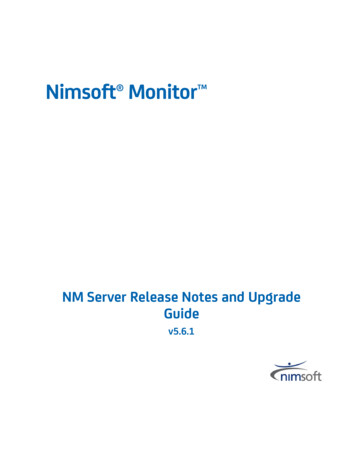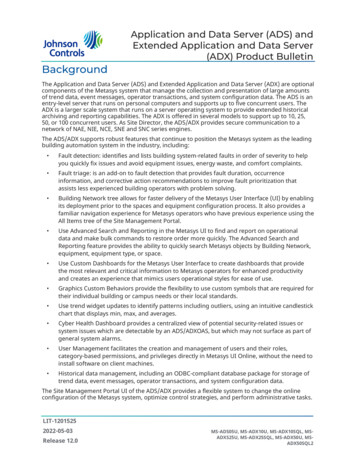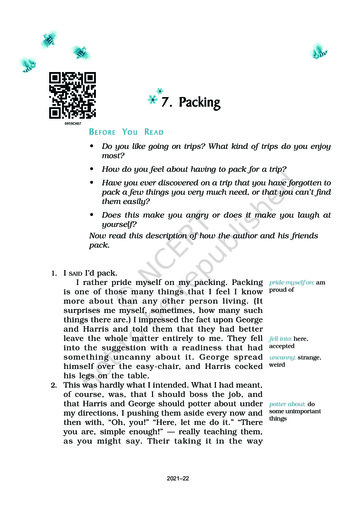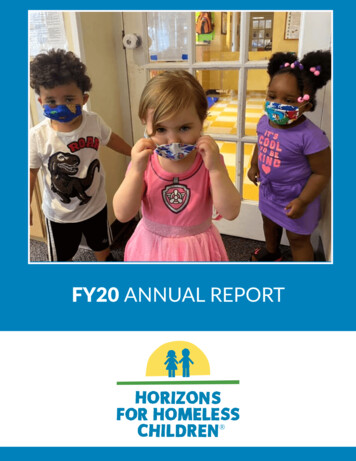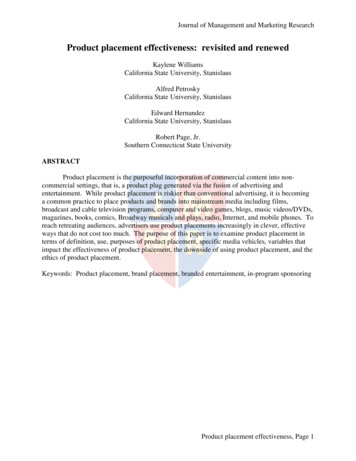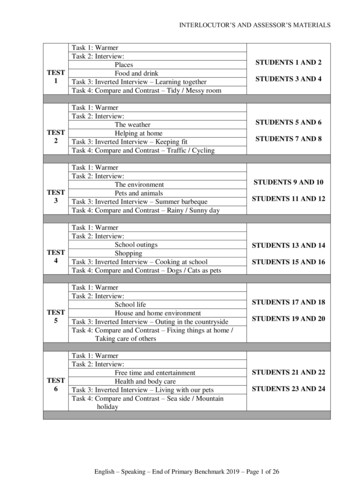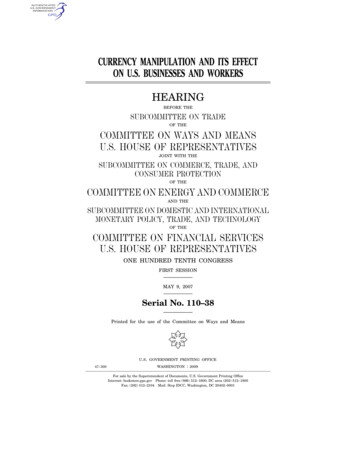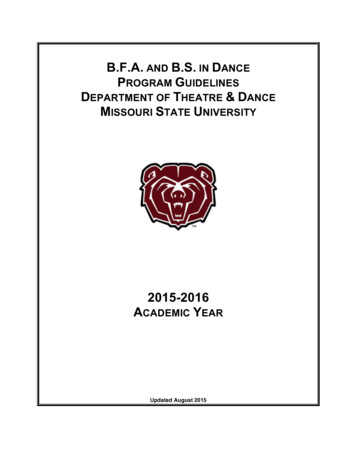
Transcription
B.F.A. AND B.S. IN DANCEPROGRAM GUIDELINESDEPARTMENT OF THEATRE & DANCEMISSOURI STATE UNIVERSITY2015-2016ACADEMIC YEARUpdated August 2015
TABLE OF CONTENTSPage #1. A MESSAGE FROM THE DANCE PROGRAM COORDINATOR32. PROGRAM DESCRIPTION AND MISSION43. FACULTY BIOS / DEPARTMENT CONTACT INFORMATION5-74. ASSESSMENTa. Admission Processb. Acceptance Criteriac. Retention Criteria: Academic, Performance, Competencyd. Retention Processe. Sample Faculty Assessment Formf. Sample Self Evaluation Formg. Sample Recommendation for Course of Studyh. Academic Advisingi. Probationj. Dismissal8-135. DEGREE INFORMATIONa. BFA in Theatre and Dance, option in Danceb. General Education Requirementsc. The BFA Review Process14-186. SCHOLARSHIPS / FINANCIAL AID197. PERFORMANCE OPPORTUNITIESa. Auditionsb. Callboardsc. Inertia Dance Companyd. Fall and Spring Dance Concertse. ACDFA Regional Conference20-218. PROGRAM PHILOSOPHY, DANCE ETIQUETTE229. BACKSTAGE AND THEATRE & DANCE POLICIES2310. DANCER’S EQUIPMENT CHECKLIST2411. ADDITIONAL INFORMATIONa. Studio Usageb. UTDc. TAD e-Updated. MST-Connecte. Health and Wellness Centerf. Study Away and Summer Intensives in Danceg. Department Productions – Rotation Schedules25-2612. LETTER OF AGREEMENT272
A MESSAGE FROM THE DANCE PROGRAM COORDINATORWelcome (and welcome back) to Missouri State University!The Missouri State Dance program is designed to help you deepen your knowledge, develop your skillsand enhance your artistry as you prepare for a career in dance. As of Fall 2015, to ensure that youreceive the best training and education available, Missouri State now offers two degree options in dance:the Bachelor of Fine Arts (BFA) and the Bachelor of Science (BS).The BFA Dance program integrates the academic with the practical, furnishing artistic and educationalexperiences that will help you flourish in a field that offers a wide range of career possibilities. We hopeyou will find a rigorous, supportive and satisfying environment in which to work, play and explore yourinterest in and passion for the performing arts.The BS in Dance is designed for students who wish to combine dance studies with either a minor or asecond major. Still providing rigorous training, this degree should enable those who choose the BS inDance to graduate in four years.The faculty is eager to assist you as you pursue your degree in Dance: in the studio, the classroom and inadvisement meetings. Feel free to seek us out – to ask questions, or just to chat – as you engage in anexciting and complex training for this most elusive of art forms.Here’s to a great year!RuthRuth BarnesProfessor, Dance Program CoordinatorDepartment of Theatre and DanceCraig Hall 351A901 S. National Ave.Springfield, MO //www.theatreanddance.missouristate.edu3
BFA IN DANCE PROGRAM DESCRIPTIONThe Missouri State University Department of Theatre and Dance offers a BFA in Theatre and Dancewith options in Acting, Dance, and Design, Technology and Stage Management. The three options sharea common core curriculum of 31 credit hours; all students then complete 47 credit hours in their majoroption.The BFA Dance program is designed to instill the knowledge and skills needed to pursue a successfulcareer in dance – whether as a performer, teacher, choreographer/director, costumer, writer, physicaltherapist or dance therapist or any other dance-related profession. All degree programs share theGeneral Education Requirements with all Missouri State University students, which include a diverseselection of classes in the arts, sciences, humanities, technology, and business.BS IN D ANCE P ROGRAM D ESCRIPTIONThe BS Dance program is designed to allow flexibility to those students interested in combining dancestudies with other degree options (a minor or a second major) while maintaining a rigorous trainingprogram in technique, choreography, history, pedagogy, dance science and other dance related topics.All degree programs share the General Education Requirements with all Missouri State Universitystudents, which include a diverse selection of classes in the arts, sciences, humanities, technology, andbusiness.DANCE PROGRAM MISSIONThe MSU Dance Program strives to maintain high standards in practical dance training – technique andcomposition work – and intellectual endeavor. The faculty aims to nurture and stimulate students in thestudio and in the classroom, providing opportunities in technique, composition, performance andteaching. In this way, the program encourages students to investigate – through creative activities andscholarly research – the multifaceted and ever-changing world of dance. This comprehensive preparationreflects the realities of the professional arena, which often contradict the assumed limits of a career indance. By taking advantage of a variety of techniques, performance experiences, the composition seriesand supplementary scholarly and practical courses, students can acquire wide-ranging skills in a varietyof facets of the discipline of dance. In this way, we encourage young artists to be prepared to meet theneeds and challenges of today’s world.“Dance is for everybody. I believe that the dance came from thepeople and that it should always be delivered back to the people.”- Alvin Ailey4
FACULTY BIOGRAPHIESRUTH BARNESM.F.A., Dance/Experimental Choreography, University of California, RiversideB.A., English and General Literature, State University of New York, BinghamtonCertificat d’Aptitude de Professeur de Danse, Ministère de la Culture, FranceInternationally known performer, choreographer and dance educator Ruth Barnes taught at the MerceCunningham Studio in New York before moving to France in the mid-1980s – and then back to the US in2000. The first American choreographer to benefit from a Fulbright Fellowship to work in the UnitedKingdom (1974-1975), she has toured worldwide as a soloist and created numerous works forprofessional companies and with independent performers in the US and in Europe. Ruth spent thesummer of 2013 in Scotland, where she collaborated with five choreographers based in Edinburgh,Glasgow and the Highlands to create Here, There and Everywhere, a 50-minute solo. Other recentprojects include Homing/In – a duet for dancers and live-feed video that also incorporated aerial work –that was presented on the 2008 Edinburgh Festival Fringe. In 2009, she directed actor/writer SheilaGordon in Folding House, a one-woman show that received a FronteraFest (Austin, TX) “Best of Fest”award and appeared on the 2009 Edinburgh Festival Fringe.Barnes’s interest in mixed-media work (live dance and video) has been seen in several projects:Angela/Christina (2009) – set on Wylliams/Henry Dance Company as Chloé/Christina (2010); Solace(2007); and Remember the Ladies, a collaboration with media artist, Professor of Art and Design VondaYarberry, first presented in Coger Theatre in 2006, and then at the Gillioz Theater on the Encore! BlackTie gala. Barnes, Yarberry and CIS Professor S Brahnam were awarded a Provost’s Futures grant fortheir 3-year project, Exploring Artificial Intelligence in Artistic Process; they presented A Proper Container,a mixed media interactive performance piece developed during the grant period, on the 2011 SpringDance Concert.Ruth Barnes teaches Modern Dance Technique, Dance Improvisation and Composition, AppliedKinesiology for the Dancer, Dance History, Dance on Camera and Dance and Technology.SARA BRUMMELM.F.A, Theater/Dance, University of ArizonaB.A., Anthropology, University of ColoradoSara Brummel Dance training includes the North Carolina School of the Arts, the Pennsylvania Ballet,and studies with Juan Antonio, Takako Asakawa, Peggy Baker, Jerry Bywaters Cochran, Robert Cohan,Blondell Cummings, Lynn Dally, Margaret Jenkins, the Louis/Nikolais Dance Theatre Lab, Bill Evans,Gary Masters, David Moroni, Nadine Ravine, George Skibine, Marjorie Tallchief, and David Hatch Walker.Performing experience encompasses a number of ballet and modern dance companies, including thePennsylvania Ballet, New England Dinosaur, Dance Company of Ontario, and Contemporary Dancers ofWinnipeg.As a teacher, Ms. Brummel's credits include the Cambridge School of Ballet, Cambridge School ofWeston, Colorado Ballet, Crested Butte Summer Dance Workshop, Dance Circle of Boston, Loretto5
Heights College, Missouri Fine Arts Academy, Montezuma/Cortez High School, SEEK SummerEnrichment Program, American College Dance Festival, Springfield Ballet, University of Denver,workshops in São Paulo, Brazil, and presentations at the Congreso de Pedagogia de Danze in Bogotá,Colombia. Ms. Brummel’s choreography has been presented in Bogotá, Seattle, Chicago, Albuquerque,St. Louis, Wichita, and Springfield.Sara Brummel is an ABT Certified Teacher, who has successfully completed the American BalletTheatre Teacher Training Intensive in Primary through Level 7 and Partnering of the ABT NationalTraining Curriculum. Ms. Brummel and Physical Therapy Professor Dr. Jim Hackney are investigating theeffect of sprung flooring on dancers’ movements, and as a tool in minimizing injury, with MSU students asthe subjects for their research. Her choreography has been presented in Bogotá, Seattle, Chicago,Albuquerque, St. Louis, Wichita and Springfield.Sara Brummel teaches Ballet, Modern Dance, Improvisation and Composition, Dance Pedagogy andDance History. She is the coordinator for the BFA Reviews and BS Senior Projects.DARRYL KENT CLARKM.F.A., Dance, State University of New York, BrockportB.F.A., Dance, Columbia College ChicagoDarryl Kent Clark, a native of Michigan, began his career as a dancer in 1981 in Chicago, Illinois, wherehe danced the works of many nationally known choreographers. His interests as a performing artistexpanded to include stints as a dancer with Princess Cruises, Vee Corporation. He has also worked asan actor with First Folio Shakespeare Festival of Oakbrook, Illinois, Rochester, New York's Geva Theater,Chicago's Marriott Lincolnshire Theater and Pegasus Players.Mr. Clark’s choreography has received favorable reviews in Dance Magazine. The recipient of an Artist'sFellowship from the Illinois Arts Council, he has been on the faculty of many dance studios n the USA,and is a featured teacher of jazz, tap and modern dance at studios and universities in the USA and theNetherlands.After serving as Head of Dance at Western Carolina University, Mr. Clark joined the faculty of theDepartment of Theater and Dance at Missouri State University.P ER C OURSE ( PART - TIME ) F ACULTYJ ULIA B UBALOJulia Bubalo began her dance training at the age of seven in Westerville, Ohio. By the age of ten, shewas dancing as a scholarship student through the Ford Foundation, a national program to assist giftedyoung dancers. This gave her an opportunity to train with Tatjana Akinfieva-Smith and dance with BalletMet, a professional company in Columbus, Ohio. In addition, she studied with the Dayton Ballet, inDayton, Ohio and at the School of American Ballet in New York. In 1987, she moved to Las Vegas whereshe trained with the Nevada Dance Theatre and traveled with them to Moscow, Russia. After moving toMemphis, TN, she performed with the Mid-South Dance Theatre.In 1991, she moved to Springfield, MO and began teaching ballet for Springfield Ballet while shecompleted a degree in Business Administration from Drury University. In 1994, she founded the OzarkDance Academy where she continues to teach, choreograph and direct. Ms. Bubalo has also been anadjunct staff instructor in the Theatre and Dance Department at Missouri State University since 2003.KATE RIEGLERKate Riegler is the director of Credo Dance Academy in Springfield, MO. She trained with Peggie Wallis,registered teacher of the Royal Academy of Dance. Kate completed the Academy’s examination course6
with distinction, allowing her to achieve status as an Associate of the Royal Academy of Dance. Katecontinued her training at The Ailey School in New York, NY. She was a finalist in the 2004 Youth ofAmerica Grand Prix and went on to dance professionally with Texas Ballet Theater under the direction ofBen Stevenson. Later, she was administrator and instructor of Texas Ballet Theater School. In 2009, shewas the children’s ballet mistress for the Aspen Santa Fe Ballet's Nutcracker, held at Walton ArtCenter. In 2010, Kate danced in St. Petersburg, Russia and at the Kremlin Palace in Moscow, Russia. Inher free time, Kate volunteers with CASA of Southwest Missouri, enjoys college sporting events, andspending time with family and friends.TERESA SIMPSONTeresa Simpson’s training covers a broad range of dance techniques including classical ballet, modern,and improvisation. Prior to earning a BFA in Dance Performance at Missouri State University (2008),Teresa studied with the St. Louis Ballet School, performing in the company's production of TheNutcracker and participating in student workshops. In college, Teresa toured with Missouri State'scommunity outreach dance company, Inertia; performed in several faculty, student, and guestchoreographer works; and presented choreography at the American College Dance Association regionalconference. After college, she helped bring to life a performing arts after-school program at the Academyof Performing Arts in Nashville, TN and continued her training with Nashville Ballet. She also holds anInternational Teaching Diploma from the North American Montessori Center (2010) and has worked as aMontessori teacher, incorporating basic creative movement into a prepared environment Montessoricurriculum. Teresa holds a Master of Science in Administrative Studies with an Arts Management focusfrom Missouri State University (2015). In addition to teaching with Springfield Ballet, Teresa is a cofounder, performer, and choreographer member with Springfield Dance Alliance, has served on the AATEMissouri Theatre in Our Schools mini conference planning committee, and has a strong interest indeveloping, promoting, and expanding outreach programs in the arts.MUSICIANS FOR DANCE CLASSES: Kyle Aho and Soo-ji Kim7
CONTACT INFORMATIONDANCE FACULTYRuth Barnes:Office: Craig 351ATel.: 417-836-5201e-mail: RuthBarnes@missouristate.eduDEPARTMENT OF THEATRE & DANCE:Dr. Christopher J. Herr, HeadCraig Hall 355Tel: 417-836-4400e-mail: CJHerr@MissouriState.eduSara Brummel:Office: Craig 356Tel: 417-836-8441e-mail: SaraBrummel@missouristate.eduJulie Williams, Administrative AssistantCraig 355Tel: 417-836-4400e-mail: JWilliams@MissouriState.eduDarryl Kent Clark:Office: Craig 346Tel: 417-836-6071e-mail: DarrylClark@missouristate.eduCathy McFall, Accounts ManagerCraig 353Tel.: 417-836-5268e-mail: CathyMcFall@missouristate.eduOTHER USEFUL NUMBERSMcDonald 203Tel.: 417-836-5960Campus SecurityTel.: 417-836-5500Taylor Health and Wellness CenterTel.: 417-836-4000Website: http://health.missouristate.edu/IN CASE OF EMERGENCY, CALL 911“We look at the dance to impart the sensation of living in an affirmation of life, toenergize the spectator into keener awareness of the vigor, the mystery, the humor, thevariety, and the wonder of life. This is the function of the dance.” Martha Graham8
ASSESSMENTADMISSION PROCESSBFA Dance Option: In addition to applying to Missouri State University, you are required to submit aformal application to the department for an audition into the BFA Dance program, with a letter describingyour motivation to pursue a degree in dance. The audition includes a three-part class (ballet, modern andjazz), as well as an informal interview with the Dance program faculty. This audition process affords usthe opportunity to evaluate your training and assess your potential. It also gives you the chance to decideif this program suits your goals and abilities.BS in Dance: The Bachelor of Science (BS) in Dance does not require an audition, but the faculty placeeach student at the appropriate level of technique. Students must take a placement class (or the BFAaudition class) before enrolling in any technique classes.ACCEPTANCE CRITERIA FOR THE BFA DANCE PROGRAMThe following serve as criteria for a student‘s acceptance into the BFA Program: Talents, abilities and potential as a dancer, choreographer and/or teacher of dance, or as a dancescholar Intellectual curiosity and desire to learn Appetite for movement Passion for the choreographic process Desire and discipline to develop a variety of professional skills Collaborative spirit and positive attitude toward self and others Artistic sensitivity Musicality Stage presenceRETENTION CRITERIAACADEMICFOR BOTH THE BFA AND THE BS DEGREE PROGRAMS: Maintenance of a cumulative GPA of 2.5 Enrollment as a full–time student Completion of 12 credits per semesterF OR THE BFA PROGRAM : Completion of a minimum of two to six technique class credit hours per semester Completion of two to three BFA Reviews in a timely mannerF OR THE BS PROGRAM : Completion of a Final ProjectPERFORMANCE (BOTH DEGREE PROGRAMS) Audition for all Dance Productions. Perform in at least two departmental concerts during your MSUeducation Participate in annual technique assessments Demonstrate artistic growth throughout training program, and make progress toward defined goals(both academic and artistic)COMPETENCYDuring each year of the Dance Program, the student will be evaluated on his/her competency andmastery of the technical and artistic skills required of a dance artist. At the conclusion of his/her course ofstudy in the program, the student should be able to: Demonstrate technical competency in Modern, Ballet, and Jazz Dance Successfully choreograph and stage an original solo work and/or group work that demonstrates theability to effectively manipulate the elements of movement, space, time, and energy Understand and utilize the performance skills of concentration, relaxation, kinesthetic awareness,musicality and risk-taking, and demonstrate these skills on stage9
Possess the ability to make interpretive choices based on dynamics, phrasing, and shading ofmovement in technical and improvisational settingsShow a demonstrated ability to manipulate the elements of space, time, and energy in technical andimprovisational settingsDemonstrate the ability to project one’s self with confidenceExhibit significant growth in self-disciplinePreserve the integrity of one's body through: nutrition, rest, and injury care and prevention; by trainingan instrument that has strength and flexibility; and by pursuing resources outside the classroom thatinclude bio-mechanics, sports medicine information, somatic practices, and physical conditioningAppreciate the importance of analytic skills and critical thinking as it applies to the individual dancerand to the art of danceDevelop clear and organized communication skills in both written and oral presentationsBecome familiar with dance history and theory and begin to formulate a working philosophy thatexplores the role of dance in society and cultureDevelop a practical and theoretical understanding of pedagogical methods and philosophies in theteaching of dance in a variety of settingsSustain an attitude of rigorous curiosity about and enthusiasm for the craft and art of danceRETENTION PROCESSAll students will be formally assessed each year of degree candidacy. These assessments evaluate thestudent‘s growth in the Retention Criteria listed. If the faculty deems the criteria are not being met, thestudent will be placed on probation for one semester. At the end of the probationary period, adetermination will be made as to whether the student should continue in the Program.The Assessment shall consist of: A Faculty Assessment: The faculty will evaluate each candidate at the end of each year, usingRetention Criteria as a tool for assessing artistic and academic growth (see forms, pp. 8-11) A Self–Assessment: The student reflects on the questions in the self–evaluation on p. 11, in order tohave a conversation with the Dance faculty. An Evaluation Meeting: The student will meet with faculty at the end of each year for the purpose ofhelping the student set goals for forthcoming semesters. At that time, the student will berecommended for continuation in the program, recommended with reservation (put on a probationaryperiod for the following semester), or dismissed from the program.“I think that probably the moments of discovery do come from a place thatis not totally organized. Order is something that we already know about.Discoveries are in a place we don’t already know about.” Twyla Tharp10
SAMPLE FACULTY ASSESSMENT FORMDance Program Assessment (Faculty Review of Student)StudentFaculty MemberAttitude:Effort:Work Ethic:Growth/Improvement:Areas That Need Attention:Reliability:Commitment to Process:Ability to Take Criticism:Contributions to Class, Department, and Productions:Contribution to Positive Performance and Educational Environment:Scholarship:(Additional comments on back)11
SAMPLE SELF EVALUATION FORMSELF-EVALUATION DANCE PROGRAM ASSESSMENTName Year in ProgramBe prepared to discuss the following in your meeting with the faculty at the end of the semester:D ANCE - RELATED A CTIVITIES :What activities have you participated in this year? Include shows and concerts in which you haveperformed at MSU, performances for which you auditioned, and any other related activities (ushering,crewing, performances at special events, participation/officer in UCYA, Inertia Dance Company, offcampus performances).T ECHNICAL PROGRESS: What are your strengths? What challenges you, and how are you addressing those challenges?G OALS : What are your short-term goals? Have you achieved them? Why? Why not? How? What are yourgoals for next year? What are your long-term goals? How do you plan to achieve them?R ANK YOUR PROGRESS IN THE FOLLOWING AREAS :NI needs improvementFP fair progressSP significant progressEP excellent progressNA no improvement requiredNP does not itioning:NIAttitude:NIOverall Physical tive GPALast semester GPAMajor GPA (cumulative)SignatureDateNOTE: You do NOT have to print this!12
SAMPLE RECOMMENDATION FOR COURSE OF STUDYDANCE STUDENT ASSESSMENT RECOMMENDATION FOR COURSE OF STUDYStudent NameProgram StatusDateDear ,After thorough and thoughtful examination of your comprehensive student performance (including allelements observed in your student assessment), the Missouri State University Dance Program facultymakes the following recommendation regarding continuation of your course of study.Recommendation for continuation of studyRecommendation, with defined reservations, for continuation of studyRecommendation for discontinuation of studyFaculty SignatureFaculty SignatureArea Coordinator SignatureDepartment Head Signature“The most essential thing in dance discipline is devotion, the steadfast and willingdevotion to the labor that makes the class work not a gymnastic hour and a half or, atthe lowest level, a daily drudgery, but a devotion that allows the classroom discipline tobecome moments of dancing, too.” Merce Cunningham13
ACADEMIC ADVISINGThis packet includes an outline of required course work and the semester breakdown for the both theBFA Dance student‘s 4-year program and the BS Dance student’s 4-year program. You will also find alink on p. 17 to the MSU General Education Requirements. Your advisor will be one of the full-time Dancefaculty members. Please consult with him/her regularly in order to ensure that your class work meets yourneeds both artistically and academically.Both programs are rigorous, and the goal of the attached schedules is to assist you to be able tocomplete your studies in 4 years – with, of course, the requirement that you continually improve intechnique.As a Dance major in either degree program, you have the advantage that your advisor is also a memberof the Dance faculty. Please make sure to consult with your advisor EVERY semester, to ensure that youcomplete your coursework in a way that will allow you to graduate in a timely manner, and as a resourcefor such things as suggestions for summer intensives, and to discuss goals upon graduating.PROBATIONIf a candidate fails to meet the Retention Criteria above, s/he will be placed on probation for one semester(Recommended with Reservation, on form 3). The Faculty will specify the nature of the student‘sdeficiencies and suggest remedies. At the end of the probationary semester, the Faculty will re-assessthe student‘s status and make all necessary determinations and recommendations. The student‘s failureto remediate his/her deficiencies will result in dismissal from the Dance Program.DISMISSALThe Department of Theatre and Dance faculty reserve the right to remove a student from the programwithout the benefit of a probationary semester whenever they deem such removal to be in the bestinterests of the student and/or the Program.“You have to love dancing to stick to it. It gives you nothing back, nomanuscripts to store away, no paintings to show on walls and maybehang in museums, no poems to be printed and sold, nothing but thatsingle fleeting moment when you feel alive.” Merce Cunningham14
15
DEGREE INFORMATION – BFA OPTION IN DANCEMissouri State University – Department of Theatre and DanceFOUR-YEAR DEGREE PLAN -- BACHELOR OF FINE ARTS IN THEATRE AND DANCEDANCE OPTION - Revised March 2014Suggested Sequencing: 15-18 credit hours per semester, unless students choose to attend summer schoolSemester 1GEP 101 or UHC 110ENG 110 Writing IMTH 130 or higherCOM 115Choose from: Elective DAN 130 Dance Fundamentals I orDAN 216 Elementary Modern or DAN 230 ElementaryBalletTHE 150/151 Intro to Theatre Technology & LabTotalHrs2333Semester 3 - 1st BFA Review (Fall or Spring)GEN ED Writing IIGEN ED Social SciencesChoose one from: DAN 216 (Elementary Modern) or DAN316 (Intermediate Modern) and/or DAN 230 (ElementaryBallet) or DAN 330 (Intermediate Ballet) and/or DAN 245(Elementary Jazz)Choose from: THE 250/251 Stagecraft and Construction& Lab or THE 255/256 Lighting Design & Lab or THE260/261 Costume Construction & LabTHE 224 Stage MakeupKIN 250 (Applied Human Anatomy) or GEN ED Humanities(MUS 241 suggested)TotalHrs33Semester 5 - 2nd BFA Review (Fall or Spring)Choose one from: DAN 316 Intermediate Modern orDAN 416 Advanced Modern &/or DAN Intermediate 330Ballet or DAN 430 Advanced Ballet and/or DAN 345Intermediate Jazz or DAN 445 Advanced JazzChoose one from: THE 250/251 Stagecraft andConstruction & Lab or THE 255/256 Lighting Design& Lab or THE 260/261 Costume Construction & LabDAN 320 Dance Composition ITHE 222 Acting Fundamentals* DAN 364 Applied Kinesiology for the Dancer* THE 541 Theatre History I or *DAN 565 Dance PedagogyTotalHrsSemester 7GEN ED Social & Behavioral SciencesChoose two from: DAN 316 Intermediate Modern orDAN 416 Advanced Modern &/or DAN Intermediate 330Ballet or DAN 430 Advanced BalletDAN 520 Choreography and Production*THE 541 Theatre History I or *DAN 565 DancePedagogyElectives (from DAN, MUS, or THE at 300 er 2GEN ED Life Science (BIO 101 – with/without BIO 121)GEN ED The Arts (DAN 180: Introduction to the Dance)GEN ED: PLS 101Choose one from: Elective DAN 131 DanceFundamentals II or DAN 216 ElementaryModern and/or DAN 230 Elementary BalletTHE 130 Script AnalysisHrs333Total14-18Semester 4GEN ED Physical ScienceHST 121 or 122 History of the U. S.Choose two from DAN 216 Elementary Modernor DAN 316 Intermediate Modern and/orDAN 230 Elementary Ballet or DAN 330Intermediate Ballet and/or DAN 245Elementary Jazz or DAN 345 Intermediate JazzKIN 250 (Applied Human Anatomy) or GEN EDHumanities (MUS 241 suggested)Hrs3-53Total15-17Semester 6GEN ED Cultural CompetencyGEN ED Social & Behavioral SciencesChoose two from: DAN 316 Intermediate Modern orDAN 416 Advanced Modern &/or DANIntermediate 330 Ballet or DAN 430 AdvancedBallet and/or DAN 345 Intermediate Jazz or DAN445 Advanced JazzDAN 420 Dance Composition II* DAN 552 Dance History Seminar* DAN 348 PartneringHrs33Total16-19Semester 8GEN ED Public IssuesChoose two from:DAN 316 Intermediate Modern or DAN 416 AdvancedModern &/or DAN Intermediate 330 Ballet or DAN 430Advanced Ballet and/or DAN 345 Intermediate Jazz orDAN 445 Advanced Jazz Elective*DAN 552 Dance History Seminar or Electives (fromDAN, MUS, or THE at 300 level)DAN 492 Senior BFA ReviewDAN 592 PerformanceHrs32-63-4633-62326-9311Total hours needed to graduate: 125,with no less than 40 hours at 300 levelTotal18-19Total14-1716
DEGREE INFORMATION – BS IN DANCEMissouri State University – Department of Theatre and DanceFOUR-YEAR DEGREE PLAN -- BACHELOR OF SCIENCE IN DANCENote: Students are required to have a minor, not included in this plan. Students are strongly encouragedto schedule one course for their minor each semester.Suggested Sequencing: 15-18 credit hours per semester, unless the student chooses to attend summer schoolAugust 2015Semester 1GEP 101 or UHC 110ENG 110 Writing IMTH 130 or higherCOM 115Choose from: Elective DAN 130 Dance Fundamentals Iand/or DAN 131 Dance Fundamentals II orDAN 216 Elementary Modern or DAN 230 ElementaryBalletTotalGEN ED Writing IIGEN ED Social SciencesChoose one from: DAN 216 (Elementary Modern) or DAN316 (Intermediate Modern) and/or DAN 230 (ElementaryBallet) or DAN 330 (Intermediate Ballet) and/or DAN 245(Elementary Jazz)KIN 250 (Applied Human Anatomy) or GEN ED Humanities(MUS 241 suggested)Hrs23333-414-15Hrs3333Semester 2GEN ED Life Science (BIO 101 – with/without BIO 121)GEN ED The Arts (DAN 180: Introduction to the Dance)GEN ED: PLS 101Choose one from: DAN 216 Elementary Modern and/orDAN 230 Elementary BalletTHE 150/151 Intro to Theatre Technology & LabHrs333Total15Semeste
All degree programs share the General Education Requirements with all Missouri State University students, which include a diverse selection of classes in the arts, sciences, humanities, technology, and business. DANCE PROGRAM MISSION The MSU Dance Program strives to maintain high standards in practical dance training - technique and

